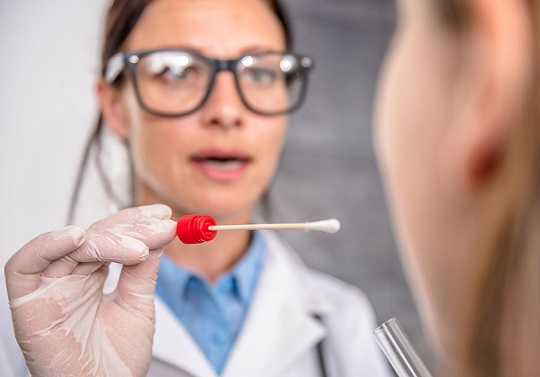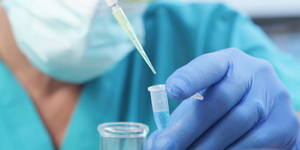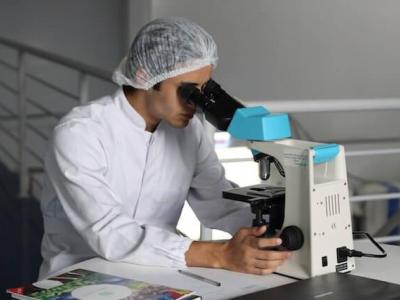- 1) Do not eat, drink, smoke or chew gum for 30 minutes before collecting samples.
- 2) The swab tips should not come into contact with any surface other that the inside of the cheek at any point before, during or after collection
- 3) Move the swab up and down while also rotating. It's very important to rotate the swab with your fingers.
- 4) Allow the swab to dry before storing. At least one hour.

- 2022-10-03 22:38:13
- Glossary of specific terms
Glossary of specific terms. Words from A to L.
As we have recently seen in other previous articles about the different DNA tests, you can find a wide variety of terms that, if not properly understood, can lead to more doubts instead of solving them. Therefore, we have designed a new section for all our clients called "Glossary of specific terms".

This section, which you may well have in an additional tab (in addition to the tabs you have opened in your browser, looking at our various articles) will teach you to decode those terms that, specifically speaking, can be difficult to understand. both results and also different procedures or varied instances.

Therefore, we have taken a little time to bring you all those terms related to genetics, so that you take them into account when: interpreting results, researching about a certain topic as soon as you want to carry out a test for different reasons, or simply to clear up doubts and read these terms.
Let's start....

Definitions of terms between A and L
A
Allele: One of two or more DNA sequences found at a given gene locus. Usually there is one common allele (normal DNA sequence) and the others are rare alleles (mutations).
Allelic heterogeneity: Presence of different variants at a specific gene locus that produce the same or similar phenotypic expression of a disease or condition.
Aneuploidy: Presence of one or more chromosomes, or absence of chromosomes leading to an imbalance in the chromosome complement. It also refers to any chromosome number that is not an exact multiple of the haploid number (23).
Cascade Detection: Systematic process for the identification of people at risk of presenting a hereditary condition within a family. The first step in cascade screening is the search for a pathogenic, or likely pathogenic, variant by broad-based analysis in a family member who is usually affected. At-risk biological relatives then undergo a test that detects only the specific familial variant. The process is repeated as more people affected or carriers of the pathogenic variant are identified.
Carrier Frequency: Proportion of individuals in a population that have a single copy of a specific recessive gene variant. Carrier frequency is also sometimes referred to as the prevalence of variants in genes with a dominant effect, such as BRCA1 and BRCA2.
Deoxyribonucleic Acid (DNA): Molecule inside the cell that contains the genetic information responsible for the development and functioning of an organism. These molecules are the means of transmitting genetic information from one generation to the next. Its structure is a double-stranded helix linked by weak hydrogen bonds between purine and pyrimidine nucleotide base pairs: adenine (A) bonds with thymine (T) and guanine (G) bonds with cytosine (C).
DL: It occurs when there are alleles (DNA markers) that, due to their physical proximity on a chromosome, occur together more frequently than would be expected by chance.
Domain: In a protein, it is a specific physical region that has a certain function or an amino acid sequence that corresponds to a specific DNA segment.
Double Heterozygosity: Presence of two different mutated alleles at two separate gene loci.

E
Epigenetic Alteration: Inherited change that influences gene expression but does not affect DNA sequence. For example, promoter methylation or histone modifications.
Exon: DNA sequence present in mature messenger RNA. Some exons code for the amino acids of proteins. Most genes have multiple exons interspersed with introns.
Extended family: Extended family. Also called kindred and relatives.

F
Family: Phenotype or trait that occurs more frequently in a given family than in the general population.
First degree relative: Parents, siblings or children of a person.
FISH: A technique for identifying the presence of specific chromosomes or chromosomal regions by hybridizing or binding denatured chromosomal DNA to fluorescently labeled DNA probes. Microscopic examination with fluorescent light allows detection of the luminescent signal of hybridization or the absence of this signal.
FSG: Uncles, grandparents, grandchildren, nephews or half brothers of a person. Also called a second degree relative.
FTG: First cousins, great-grandparents, great-uncles, great-nephews, great-grandchildren, or half-siblings of one of a person's parents. Also called a third degree relative.

Gene: The fundamental unit of heredity that passes from parents to children. Genes are made up of DNA sequences and are arranged, one after another, at specific locations on chromosomes in the nucleus of cells. They contain information to make specific proteins that lead to the expression of a particular physical trait or characteristic, such as hair or eye color, or that have a particular function in a cell.
Genealogical Tree: Family history chart using standardized symbols. In a family tree, the relationships between relatives are represented and the members of the family that have certain pathogenic genetic variants, traits and diseases are indicated, in addition it is indicated if they have already died. This diagram is used to determine the type of inheritance of a disease within a family group.
Genotype: In its broadest sense, genotype refers to the complete genetic makeup of an individual. It is often used in a narrower sense to refer to the set of alleles present at one or more specific loci.
Genotyped: Laboratory process for analyzing an individual's germline DNA to identify specific nucleotides or bases that can determine the presence of certain variants. Genotyping is different from sequencing, in which all nucleotides in a DNA segment of a specific length are analyzed.
Genetic Anticipation: Phenomenon in which the signs and symptoms of some genetic conditions become more severe or appear at younger ages as the disorder is passed from one generation to the next.
Genetic Screening: The process of genetically testing a population to identify individuals at increased risk for a specific genetic disorder or who are carriers of a genetic variant associated with a specific disorder.
Genetic Heterogeneity: Describes different genetic mechanisms that produce the same phenotype, or similar phenotypes. There are two types of genetic heterogeneity: allelic heterogeneity and locus heterogeneity. Allelic heterogeneity occurs when different variants at a specific gene locus produce the same or similar phenotypic expression of a disease or condition. Locus heterogeneity occurs when variants at different gene loci cause the same or similar phenotypic expression of a disease or condition.
Germ Line: Cells that give rise to eggs and sperm.
Germ Line DNA: Refers to DNA from tissues derived from reproductive cells (eggs or sperm) that is incorporated into the DNA of all cells of the offspring. A germline mutation is passed from parent to offspring.

H

I
Informative: In linkage analysis, it refers to the ability to differentiate maternally inherited and paternally inherited DNA markers (polymorphisms) that are within or near a gene of interest.
Informed consent: Process of exchanging information between a health professional and a person or their legal representative, whose purpose is to facilitate autonomous and informed decision-making. The informed consent process for genetic testing should include an explanation of the medical and psychosocial risks, benefits, limitations, and potential implications of genetic testing; it also includes a discussion of privacy, confidentiality, documentation, and processing of genetic test results, as well as options for treating the risk of inherited diseases.
Insertion: A type of genetic change that involves the addition of a segment of DNA.
Intron: DNA sequence located between exons that is first transcribed into RNA but is removed from the final RNA transcript, and thus does not change the amino acid code.
Investment: Chromosomal abnormality in which a chromosome segment breaks and then rejoins, but in the reverse direction.

L
Linkage Disequilibrium: It occurs when there are alleles (DNA markers) that, due to their physical proximity on a chromosome, occur together more frequently than would be expected by chance.
Ligation: The tendency for genes or DNA segments to segregate together during meiosis when they are located very close together on a chromosome and are therefore inherited together.
Locus: Site or physical location of a specific gene on a chromosome.
Locus heterogeneity: Presence of variants at different gene loci that cause the same or similar phenotypic expression of a disease or condition.

Conclusion
Here ends the first part of specific terms and definitions that you need to be able to easily understand those words that are difficult to understand.

We provide a DNA testing service that has international reach. Wherever you are, we will help you and guide you step by step, what you must do to place your order and how to send it to our laboratories.
We are here to help. You can also leave us a comment below. We will respond to you shortly.
- Can food or drinks, alter the results of DNA tests? Find out here!
- About DNA Samples and Client Data Privacy
- What is possible and what not to know through a paternity test?
- How to carry out a DNA test if I live abroad?
- DNA tests between siblings. Information and guide to perform the brotherhood test.
- Avuncular test between uncles and nephews. Cheap, fast and easy to do.
- Grandparents. Useful Info to realize test DNA
Categories
-
DNA sampling - Kit
-
DNA Test
-
DNA Test - Paternity
-
DNA testing grandparents grandchildren
-
DNA Tests - Judicial Proceedings
-
Frequently asked questions and answers
-
Glossary of specific terms
-
Maternity DNA tests
-
NON - invasive Prenatal DNA
-
Sibling DNA testing
-
Uncles-nephews DNA tests
Popular articles

How it works

Step 1 - Order your kit.
Click ORDER NOW, place your order and you will receive the sample collection kit in a couple of days.
Please contact us at 1-877-219-4485 or WhatsApp +1 647 455 0443 if you are having any troubles ordering.

Step 2 - Take the samples.
Collect the swab samples from the test participants.
Please Watch This Video.

Step 3 - Send the samples to us by mail
Place each pair of swabs in different envelopes (parent / child), then place the two smaller envelopes inside the larger envelope and mail it to the address specified in the instructions.

Step 4 - DNA analysis of your saliva samples in our laboratory
Once we receive the samples, we will send you an email to confirm the reception of the samples and proceed to perform the DNA test in our laboratory . You can follow up online at any time using your unique access code to know the progress status of the DNA study.

Step 5 - Receive your results.
Receive your certified results by email, usually about three days, after your samples arrive at the Lab.










Comments
Jack